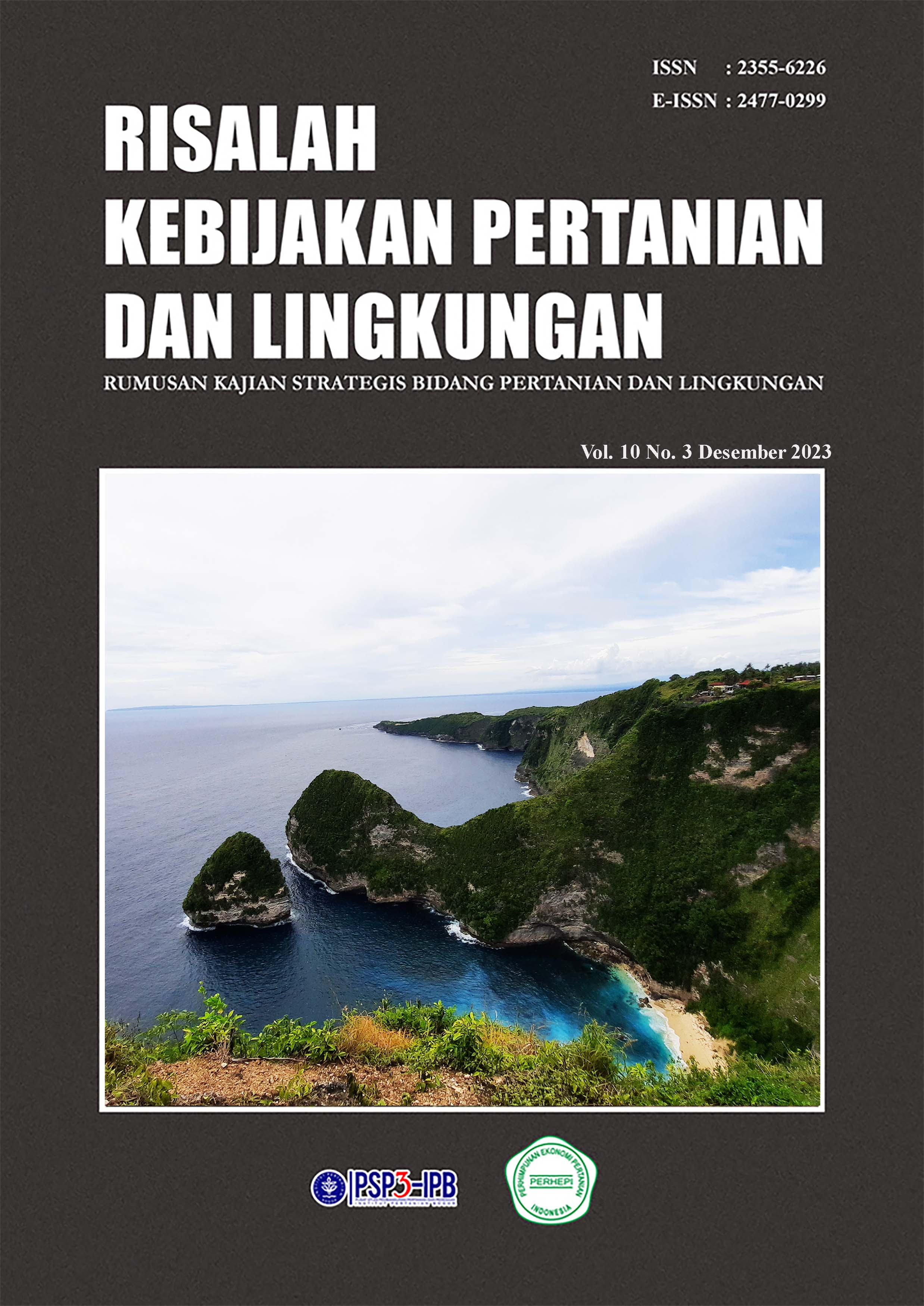HUBUNGAN FAKTOR LINGKUNGAN TERHADAP PRODUKSI SERASAH MANGROVE TELING TOMBARIRI, TAMAN NASIONAL BUNAKEN
Abstract
This study aims to compare ecosystem productivity based on litter production rate associated with tree species and climate parameters in the Teling Tombariri Mangroves, Bunaken National Park, North Sulawesi. Litter collection was carried out for 12 months in the three main mangrove constituent zones, the litter was then analyzed based on fraction and type. Litter production was then correlated with rainfall, ambient temperature, and humidity using a simple correlation coefficient. Linear correlations between monthly litter production of leaf, twig, fruit-flower fractions (reproductive fraction) of each mangrove species and monthly climate parameters (temperature, rainfall, and humidity) were calculated using Pearson's correlation p<0.01. The results showed that the litter production rate in the Teling Tombariri Mangrove of Bunaken National Park was highest for the type Sonneratia alba, followed by Rhizophora apiculata, and finally Bruguiera gymnorhiza. The largest litter fraction was the leaf component, followed by twigs and reproductive components (flowers and fruit), except in Sonneratia alba where the reproductive component fraction was higher than the twig component. Furthermore, the environmental factor that shows the strongest correlation with litter production is rainfall, and this applies to the three main types of Teling Tombariri mangroves.
Metrics
Downloads
References
Aida, G.R., Wardianto, Y., Fahrudin, A., Kamal, M.M. 2014. Produksi serasah mangrove di Pesisir Tangerang, Banten. Jurnal Ilmu Pertanian Indonesia, 19(2), 91-97. https://journal.ipb.ac.id/index.php/JIPI/article/view/8803.
Farooqi, Z., Pirzada, J.S., Munawwer, R. 2014. Changes inorganic, inorganic contents, carbon nitrogen ratio in decomposing Avicennia marina and Rhizophora mucronata leaves on tidal mudflats in Hajambro Creek, Indus Delta, Pakistan. Journal of Tropical Life Science, 4(1), 37-45. https://doi.org/10.11594/jtls.04.01.07.
Inayah, A., Kaswanto, R.L. 2023. Nilai biodiversitas lanskap mangrove DKI Jakarta, Kelurahan Penjaringan, Kecamatan Muara Kamal, Jakarta Utara. Jurnal Pengelolaan Lingkungan Berkelanjutan, 7(2), 118-134. https://doi.org/10.36813/jplb.7.2.
Kalitouw D.W., Darusman D., Kusmana, C. 2015. Potensi ekonomi ekosistem hutan mangrove di Desa Kulu, Kecamatan Wori Kabupaten Minahasa Utara. Risalah Kebijakan Pertanian dan Lingkungan, 2(1), 17-24. https://journal.ipb.ac.id/index.php/jkebijakan/article/view/10363.
Kaunang, T.D., Kimbal, J.D. 2009. Komposisi dan struktur vegetasi hutan mangrove di Taman Nasional Bunaken Sulawesi Utara. Agritek, 17(6), 139-148.
Kolinug, K.H., Langi, M.A., Ratag, S.P., Nurmawan, W. 2014. Zonasi tumbuhan utama penyusun mangrove berdasarkan tingkat salinitas air laut di Desa Teling Kecamatan Tombariri. Cocos, 5(4), 1-7. https://doi.org/10.35791/cocos.v5i4.6561.
Kusmana, C., Pradyatmika, P., Husin, Y.A., Shea, G., Martindale, D. 2000. Mangrove litter-fall studies at the Ajkwa Estuary, Irian Jaya, Indonesia. Indonesian Journal of Tropical Agriculture, 9(3), 39-47. https://doi.org/10.18343/ijta.vol9.iss03.pp39-47.
Mosyaftiani, A., Kaswanto, R.L., Arifin, H.S. 2018. Potensi tumbuhan liar di sempadan terbangun Sungai Ciliwung di Kota Bogor sebagai upaya restorasi ekosistem sungai. Risalah Kebijakan Pertanian dan Lingkungan, 5(1), 1-13. https://doi.org/10.29244/jkebijakan.v5i1.29781.
Noor, Y.R., Khazali, M., Suryadiputra, I,N,N. 2006. Panduan Pengenalan Mangrove di Indonesia. Bogor: Wetlands International Indonesia.
Pribadi, R. 1998. The ecology of mangrove vegetation in Bintuni Bay, Irian Jaya, Indonesia. Disertasi, tidak dipublikasikan. Departement of Biological and Molecular Sciences University of Stirling. Scotland.
Pradisty, N.A., Amir, A.A., Zimmer, M. 2021. Plant species-and stage-specific differences in microbial decay of mangrove leaf litter: The older the better?. Oecologia, 195, 843–858. https://doi.org/10.1007/s00442-021-04865-3.
Pradisty, N.A., Frida, S., Yuntha, B., Ipanna, E.S., Mohammad B. 2022. Litterfall and associated macrozoobenthic of restored mangrove forests in abandoned aquaculture ponds. Sustainability, 14(13), 8082. https://doi.org/10.3390/su14138082.
Sukardjo, S. 2004. Fisheries associated with mangrove ecosystem in indonesia: a view from mangrove ecologist. Biotropia, 23, 13-39. https://doi.org/10.11598/btb.2004.0.23.201.
Kushartono, E.W. 2009. Beberapa aspek bio-fisik kimia tanah di daerah hutan mangrove Desa Pasar Banggi Kabupaten Rembang. Jurnal Ilmu Kelautan, 14(2), 76-83. https://doi.org/10.14710/ik.ijms.14.2.76-83.
Zamroni, Y., Rohyani, I.S. 2008. Produksi serasah hutan mangrove di Perairan Pantai Teluk Sepi, Lombok Barat. Biodiversitas, 9(4), 284-287. https://doi.org/10.13057/biodiv/d090409.
Copyright (c) 2023 RISALAH KEBIJAKAN PERTANIAN DAN LINGKUNGAN: Rumusan Kajian Strategis Bidang Pertanian dan Lingkungan

This work is licensed under a Creative Commons Attribution 4.0 International License.
PUBLICATION ETHICS
Jurnal Risalah Kebijakan Pembangunan Pertanian dan Lingkungan (JRKPL) is a peer-reviewed journal publishing original research to develop a coherent and respected network of landscape architecture knowledge. JRKPL committed to upholding the highest standards of publication ethics that clarifies ethical behavior of all parties involved in publishing a scientific article in JRKPL.
As publisher of JRKPL, PSP3-LPPM IPB and PERHEPI takes its duties of guardianship all stages of publishing process and we recognize our ethical and other responsibilities.
Duties of Authors
An author should not publish manuscripts describing essentially the same research in more than one journal or primary publication. Submitting the same manuscript to more than one journal is unacceptable and constitutes unethical publishing behavior. In general, an author should not submit for consideration in another journal a previously published paper.
Authorship should be limited to those who have made a significant contribution to the manuscript and should be listed as co-authors. Where there are others who have participated in certain substantive aspects of the research project, they should be acknowledged as contributors. The corresponding author should ensure that all co-authors have seen and approved the final version of the paper and have agreed to its submission for publication.
The authors should ensure that they have written entirely original works, and if the authors have used the work and/or words of others, that this has been appropriately cited or quoted. Plagiarism are include passing off another paper as the author own paper, copying or paraphrasing substantial parts of another paper (without attribution) and claiming results from research conducted by others. Plagiarism constitutes unethical publishing behavior and is unacceptable. Plagiarism detected works will be banned for further publication procedure.
The authors acknowledge that they have disclosed all and any actual or potential conflicts of interest with their work or partial benefits associated with it. All sources of financial support for the project should be disclosed. Potential conflicts of interest should be disclosed at the earliest stage possible.
Duties of the Editorial Board
Review Process
JRKPL is committed to objective and fair double-blind peer-review to prevent any actual or potential conflict of interests between the editorial and review personnel and the reviewed material. JRKPL chooses reviewers based on their expertise (whose most closely matches the topic of the paper). At least 2 reviewers are invited to evaluate a manuscript. In cases of controversy or disagreement regarding the merits of the work, an additional review will be solicited. The JRKPL editor mediates all interaction between authors and reviewers, and the review results owned by JRKPL.
Publication Decisions
The editor of a peer-reviewed JRKPL is responsible for deciding which of the articles submitted to the journal should be published. The validation of the work in question and its importance to researchers and readers must always drive such decisions. The final decision on article acceptance based on reviewer's opinions, suggestions, and comments. The editor may confer with other editors or reviewers in making this decision.
Fair Play
JRKPL evaluates manuscripts only based on the intellectual content. No race, gender, sexual orientation, religious belief, ethnic origin, citizenship, or political philosophies of the authors are considered in the evaluation process.
Confidentiality
JRKPL assure the confidentially of the manuscripts, actors, and other related information on the publishing process. Only corresponding author, reviewers, potential reviewers, other editorial advisers, and the publisher are allows for the information.
Disclosure
Unpublished materials disclosed in a submitted manuscript must not be used in an editor's own research without the express written consent of the author. Privileged information or ideas obtained through peer review must be kept confidential and not used for personal advantage.
Duties of reviewers
(1) Objectivity: Reviewer should provide written and unbiased feedback to the authors, personal criticism of the author is inappropriate. Reviewer comments should be clearly with supporting arguments indicating whether the writing is concise and relevant
(2) Expertise: Reviewer who feels unqualified to review the research reported in a manuscript or knows that its prompt review will be impossible should notify the editor and excuse himself from the review process.
(3) Acknowledgement of sources: Reviewer suggest relevant published work that has not been cited by the authors to improve the quality of the manuscript,
(4) Confidentiality: Reviewer should maintain the confidentiality of the review process. Privileged information or ideas obtained through peer review must be kept confidential and not used for personal advantage.
(5) Disclosure and conflict of interest: Unpublished materials disclosed in a submitted manuscript must not be used in a reviewer own research without the express written consent of the author. Reviewers should not consider manuscripts in which they have conflicts of interest resulting from competitive, collaborative, or other relationships or connections with any of the authors, companies, or institutions connected to the papers.























